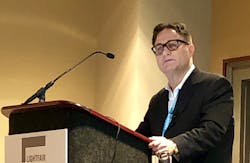Lightfair attendees at the “Evolving Opportunities in Utility Rebate Programs” session were treated to a lively discussion on trends in rebate programs. A major point of discussion was move to a whole building concept of rebates rather than focus on individual products.
In the past, many utilities offered rebates for LED replacement lamps, but Chris Wolgamott, senior product manager for commercial and residential lighting, Northwest Energy Efficiency Alliance (NEEA), said that in the Pacific Northwest market area and throughout the United States he has seen more electric utilities develop rebate programs to incentivize customers to tie their commercial/industrial lighting systems to HVAC systems.
“LEDs are amazing, but once they are in, there is not much room for the utility to do,” he says. “We are going to system integration, networked lighting control, and a focus on comfort for occupants tied into other mechanical systems.”
Wolgamott said electric utilities in the Pacific Northwest are active with rebates because they want to reduce demand so they don’t have to build any large power plants. In an ideal world, they would like their demand to be consistent, but the reality is there are constant peaks and valleys in the electrical load. Therefore, they’re always trying to “shave these peaks and fill the valleys” with more precise demand management. He added that utilities would like to be able to incentivize customers to reduce power on an extraordinarily local basis in real time, possibly even down to specific substation’s coverage areas, if they suddenly detect a surge in demand from that area.
Will Walker, senior manager, program strategy, Energy Solutions, helps utilities manage their rebate programs. He said many of today’s rebate programs are structured in three ways:
- Individual applications for rebates by product type, which has evolved from mail-in rebate programs to online applications.
- Upstream/midstream Programs where distributors often work with electrical contractors to get rebates for projects.
- Direct install programs where utilities work directly with contractors who have access to a select amount of funds.
Several of the speakers said utility rebate programs present some definite business opportunities for electrical distributors who take the time to learn their details of their local utilities’ rebate programs.
Howard Merson is the business development and sales manager for VEIC, Burlington, VT, a company that helps utilities across the country administer rebate programs and works with businesses, associations, and other entities on their energy solutions. He has a unique perspective on the role distributors can play because his family’s business, Southern Electric Supply, Meridian, MS, was actually the first U.S. electrical distributor purchased by Rexel. Merson worked for Rexel for quite a few years before getting involved with utility rebate programs over the past few years and joining VEIC in 2018.
Merson said that one interesting trend in the rebate world is that the electrical contractors who have expanded into HVAC work are learning how to utilize rebate programs for a broader selection of products. He also said distributors should check with their local utilities about when rebates may be available for smart load centers. Rebates for electric vehicle charging stations are also becoming more common, he noted.
“Lighting programs are not going away but they are changing, said NEEA’s Chris Wolgamott. “We are going away from widgets and going to systems.”
About the Author
Jim Lucy
Editor-in-Chief of Electrical Wholesaling and Electrical Marketing
Jim Lucy has been wandering through the electrical market for more than 40 years, most of the time as an editor for Electrical Wholesaling and Electrical Marketing newsletter, and as a contributing writer for EC&M magazine During that time he and the editorial team for the publications have won numerous national awards for their coverage of the electrical business. He showed an early interest in electricity, when as a youth he had an idea for a hot dog cooker. Unfortunately, the first crude prototype malfunctioned and the arc nearly blew him out of his parents' basement.
Before becoming an editor for Electrical Wholesaling and Electrical Marketing, he earned a BA degree in journalism and a MA in communications from Glassboro State College, Glassboro, NJ., which is formerly best known as the site of the 1967 summit meeting between President Lyndon Johnson and Russian Premier Aleksei Nikolayevich Kosygin, and now best known as the New Jersey state college that changed its name in 1992 to Rowan University because of a generous $100 million donation by N.J. zillionaire industrialist Henry Rowan. Jim is a Brooklyn-born Jersey Guy happily transplanted with his wife and three sons in the fertile plains of Kansas for the past 30 years.
